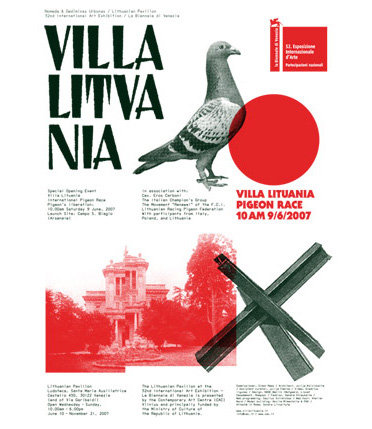8/6/2007
Nomeda & Gediminas Urbonas
Ludoteca, Venezia
Villa Lituania: flying in the face of history. The project is an anarchitectural restoration of a grand house that stands at Via Nomentana in Rome. The two artists are interested in studying the transformation of Lithuanian society going through a transitional period of changes.

Villa Lituania: flying in the face of history
Villa Lituania is a grand house that stands at Via Nomentana 116 in a respectable district of Rome. A number of national embassies to Italy are situated on via Nomentana as is Villa Torlonia the historical property bestowed upon Mussolini by the Roman nobility. Recently restored, the Villa Torlonia languished in disrepair for 60 years because of its brush with the irruption of mid-20th century history.
The project for La Biennale di Venezia by Lithuanian artists Nomeda & Gediminas Urbonas is an anarchitectural restoration of Villa Lituania. As the name of the property suggests the building is associated with the Lithuanian nation: it was the Embassy of the first independent Republic of Lithuania (1918-1940) to Italy. The Embassy operated from 1933-1940 but became a possession of the USSR after the Soviet occupation of Lithuania. The keys to the property, which had been in safe keeping, were handed by Italian government representatives to Soviet officials in step with the alliance of powers signaled by the Molotov-Ribbentrop Pact (1939).
Since the disintegration of the Soviet Union in 1990-91 and the formation of the Republic of Lithuania the Villa has remained the property of Russia; operating as the Consulate in Rome. It is considered the last occupied territory of Lithuania, and Lithuanian governments have lobbied internationally for its restitution. Now two of the nation's leading artists are taking up its cause. Their approach -qua the anarchitects Acconci, Matta-Clark, and Smithson - belongs to the symbolical field.
Working with pigeon breeders in Italy and Lithuania, Nomeda & Gediminas Urbonas are staging two pigeon races from Venice to Rome. A pigeon-loft is being constructed in the Eternal City and the birds specially bred and trained for several months under the auspices of an Italian professional (the fledglings will come from Italy, Lithuania, Poland, and Russia). Pigeon's metriculate the loft they make their first flight from as home and always return to that location when released - hence the nomenclature ‘homing pigeon'.
The artistic team involved in the project are making every effort to gain permission to build the pigeon loft in the grounds of Villa Lituania - a process that is being documented. If that effort fails, the loft - to be christened Villa Lituania - will be constructed in neutral territory in Rome.
The project's symbolism is clear - sending a sign of peace from Lithuania to Villa Lituania, Russia, and Italy. The pigeon is a fundamental avatar: they are a quotidian presence on piazza San Marco in Venice and in Rome. Moreover, the colomba della pace is an important motif within Baroque art and ornament; none more prominent than those adorning Bernini's Baldachin (1624-1632) and apse of the Triumph of the Chair of St. Peter (1666) comprising the high altar of St Peter's Basilica at the Vatican. Homing pigeons faced extinction at the hands of the Nazi's who attempted to exterminate them and erase their espionage potential. (Stocks were saved, at great risk, by a family in Belgium and their birds remain the principal racing pigeon bloodline).
Picasso even based his Dove of Peace (1949/1962) on a pigeon - a bird that appears many times in his work - as they are more peaceful than doves (ironically, doves are fiercely aggressive and territorial birds). Picasso's symbolism lost its innocence, however, when lent to Stalin's USSR. Even after the revelations of Stalin's crimes and the invasion of Hungary in 1956 Picasso refused to renounce his faith in Soviet communism and as late as 1981 his Dove appeared on a Soviet postage stamp. This story about Picasso is but a shadow as his Dove of Peace has flown around the world, and registers in the collective unconscious, as a symbol of goodwill.
At a moment when birds are high in the public-mind - and truly considered agents of change - Nomeda & Gediminas Urbonas are attempting to harness their symbolical power to change the fate of Villa Lituania. Even if the real-politik remains grounded the concept will fly like Homer's Epea pteroenta "winged words".
Simon Rees
Nomeda & Gediminas Urbonas are artists living and working in Vilnius. Both seduced by the flexibility of heterogeneous practice, they commit themselves to study the transformation of Lithuanian society going through a transitional period of changes. Since 1993 they develop interdisciplinary art program - a model for social and artistic practice with the interest to design organizational structures that questions the relativity of freedom. Their methodology varies from archival research to building complex works as production sites.
Merging tools of new and old media their projects chart out the territory of articulation of contemporary artistic practice that often challenges media and sometimes politics. Building on collaborative pattern of creative commons based communication networks Nomeda & Gediminas Urbonas develop projects that employ scenarios floating between media history and reality. They render a body of work into a mapping device to redraw a traditional pattern that concerns relations of identity politics in the contemporary society. They have exhibited their works at Documenta 11 in Kassel, Manifesta 4 in Frankfur/Main, Berlin and Gwangju Biennales among numerous other international and solo shows.
more about artists at:
http://www.nugu.lt/dossier
Presented by the Contemporary Art Centre (CAC), Vilnius
Special event: Villa Lituania International Pigeon Race. Pigeons’ liberation: 10.00 am Saturday 9 June, 2007 (in Campo San Biagio
Ludoteca
Santa Maria Ausiliatrice (Castello) 450 - Venezia



